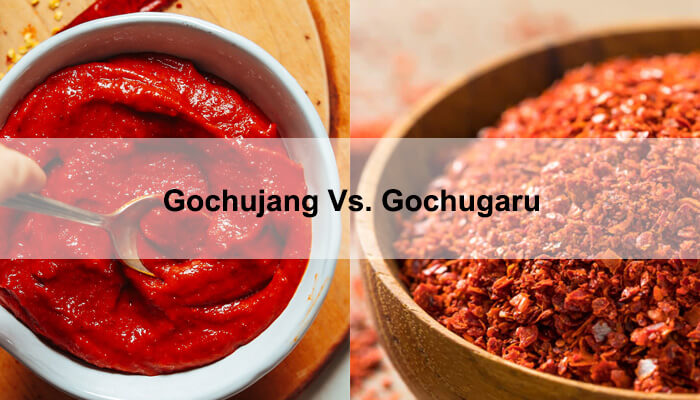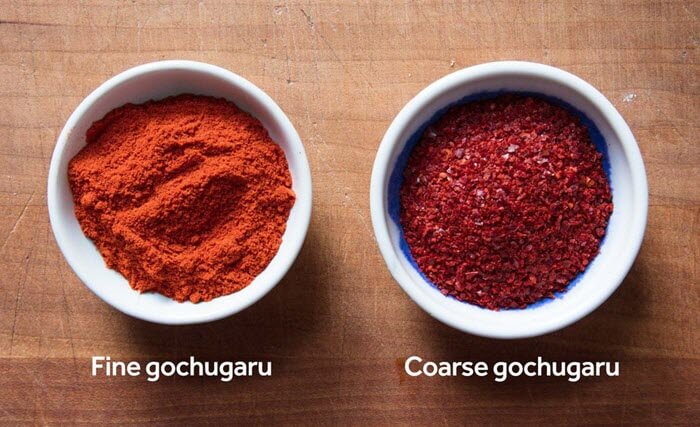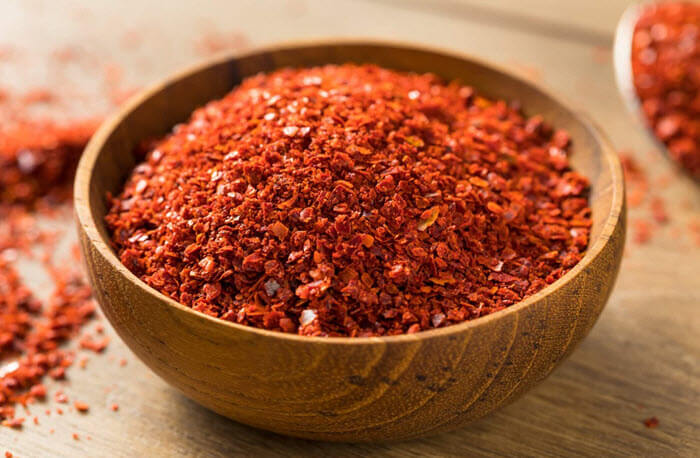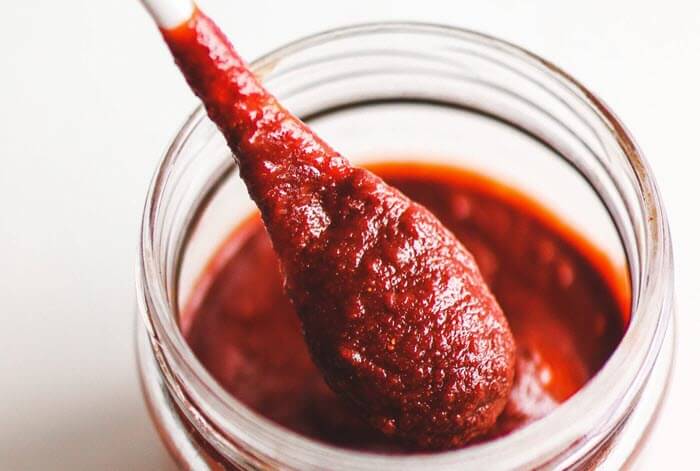Korean cuisine has become increasingly popular outside of its native country. Many dishes may come to mind when you think about Korean food, such as Bulgogi, Kimchi, and Bibimbap.
However, you can’t talk about Korean food without including spicy items. And the key to this spicy flavor is gochugaru and gochujang.
But is gochugaru the same as gochujang? Not quite. Let’s take a look at these two items side by side.
Table Of Contents
Gochugaru vs. Gochujang: Key Differences to Know
While the ingredients share many characteristics, when it comes to gochugaru vs. gochujang, the two are quite different.
Differences
The names themselves imply a significant difference. Gochu means “pepper” in the Korean language, while Garu means “powder” and Jang means “paste.” So gochugaru is a pepper powder, and gochujang is a pepper paste.
However, both items are spicy and possess a red color, as they are both derived from red chili peppers. The main differences between gochugaru and gochujang are found in the texture and appearance, flavor, method of production, and uses in Korean dishes.
So let’s take a look at some of these differences.
Gochugaru | Gochujang | |
Texture and Appearance | Powder, a light to medium shade of red | Paste, much thicker consistency and darker shade of red |
Flavor | Spicy & smoky | Spicy & smoky, together with a sweet note |
Spice Level | Hotter than gochujang | Ranging from mild to hot |
Method of Production | Crushed red chili peppers | More ingredients involved, needs to be fermented |
Uses | Stews, soups, seasoning, and vegetable sides | Soups, meats, and side dishes |
Can You Use Gochujang Instead of Gochugaru?
Gochujang is one of the great substitutes for gochugaru, it is a chili paste that is made from red chili peppers, glutinous rice, fermented soybeans, and salt. It is a little sweeter and more mellow than gochugaru, which is made from red pepper flakes.
So if you are out of gochugaru, or if you just want to try something different, you can use gochujang instead in some recipes such as kimchi.
Just be sure to adjust the amount of sugar and salt in your recipe, since gochujang is a little sweeter and saltier than gochugaru.
Details About Gochugaru
Texture and Appearance
Gochugaru, as was mentioned before, is a powder. This powder can be coarse or fine, depending on the kind you obtain. The texture can be like chili pepper flakes found in the U.S. or as fine as salt. Unlike many pepper flakes found here, the pepper seeds are removed.
Typically, gochugaru is a light to medium shade of red, determined by the peppers or other ingredients used and the manufacturing process.
Flavor
The flavor of gochugaru is mainly characterized by its spiciness. However, gochugaru contains a more complex flavor profile than just spicy.
This item will add spice and a hint of smokiness to your dishes since the peppers that are crushed into the powder are sun-dried. For this reason, gochugaru is an essential ingredient in many Korean dishes.
Spice Level
Gochugaru varies in spice level. You can obtain this powder in mild to hot variations, which will range anywhere from 1,500 to 10,000 Scoville Heat Units (SHU), which is the spice level of many hot sauces you will find on the shelf.
Traditional gochugaru will lie somewhere in between this range. For many Korean dishes, you can use gochugaru of any spice level.
Method of Production
Gochugaru is essentially crushed red chili peppers. However, the peppers are sun-dried beforehand, adding a rich profile of flavors.
Typically, the core and seeds of these peppers are removed. Then the peppers are ground to a coarse or fine powder, depending on the method used. A rice mill is usually the method of grinding for a fine texture.
And it’s as simple as that! Many will purchase dried peppers and make their own gochugaru.
Uses
Gochugaru is used in a variety of Korean dishes. If it’s spicy, it likely contains gochugaru. This powder is typically used in stews, soups, seasoning for meat and fish, and vegetable side dishes.
Some examples of dishes that use gochugaru are Kimchi, Tukbokki (spicy rice cakes), Dakdoritang (chicken stew), Jeyukbokkeum (spicy marinated pork), and gochujang. That’s right, gochugaru is a key ingredient in gochujang.
Details About Gochujang
If you want to know the best Gochujang in the market, simply check out our latest research here: 8 Best Gochujang You Should Know
Texture and Appearance
Gochujang, or pepper paste as we defined before, is of a much thicker consistency than gochugaru. This is because gochujang contains other ingredients combined with red chili peppers to create a paste.
As is the case with gochugaru, you will typically not find pepper seeds in gochujang. Compared to gochugaru, gochujang is usually a much darker shade of red.
Flavor
Gochujang is a spicy paste. While the flavor profile of gochugaru is attributed mainly to the drying process of the peppers that are used and the peppers themselves, gochujang contains flavors from red chili peppers, rice, fermented soybeans, salt, and a sweetener such as sugar or honey.
Due to the variety of ingredients, gochujang contains the spice and smokiness of gochugaru but is accompanied by a sweet note and unique flavors from the fermented soybeans.
Spice Level
Gochujang is available in various spice levels, ranging from mild to very hot. This will depend mainly on the ingredients and peppers that are used.
In a gochujang vs. gochugaru spicy level showdown, which item comes out on top? At their hottest levels, gochugaru will typically be spicier. This is mainly due to the fact that gochujang contains other ingredients, such as rice and sweeteners, that will mute some of the spice.
Gochugaru is a pepper that is simply dried and ground, retaining most of its spicy flavor. However, gochujang used in famously spicy dishes like Buldak are significantly spicier, as they contain hotter chili peppers.
Like gochugaru, gochujang of any spice level can be used in most Korean dishes.
Method of Production
Gochujang requires quite a bit more preparation than gochugaru. Not only are more ingredients involved, but gochujang also needs to be fermented, which is done in a specific container and during specific times of the year (in Korea, November-February).
These ingredients, which include fine gochugaru, rice powder, rice or wheat flour, fermented soybean powder, malt barley syrup, and salt, need to be prepared individually beforehand. These ingredients are then progressively combined until the paste is formed, placed in the container, covered, and left in the sun to ferment for six months.
Uses
Gochujang is found in many Korean dishes. The consistency and flavor complement soups, meats, and side dishes very well.
Some well-known Korean foods that contain gochujang are Soondubu (tofu soup), Bibimbap, and Korean fried chicken.
Final Thoughts
Gochugaru and gochujang are different in many ways.
But their role in Korean cuisine is equally important. The flavors of these key ingredients have popularized Korean food internationally. Due to this fact, gochugaru and gochujang can also be obtained relatively easily, even in the US.
So purchase your own set of this delicious powder and paste. You can implement them in your own Korean cooking or in other food items, as well!




